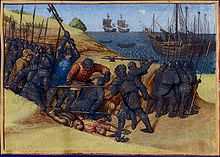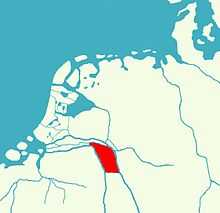Hygelac


Hygelac (Old English: Hygelāc; Old Norse: Hugleikr; Proto-Germanic: *Hugilaikaz;[1] Latin: Chlochilaicus; died c. 521) was a king of the Geats according to the poem Beowulf, which gives his genealogy: according to Beowulf, he was the son of Hrethel and had two brothers Herebeald and Hæpcyn and an unnamed sister who was married to Ecgtheow and mother of the hero Beowulf. Hygelac was married to Hygd and they had their son Heardred, and an unnamed daughter who married Eofor. When Hygelac's brother Hæthcyn was fighting with the Swedes, Hygelac arrived one day too late at Hrefnesholt to save his brother Herebeald, but managed to rescue the surviving Geatish warriors, who were besieged by the Swedish king Ongentheow and his three sons. The Swedes found refuge at a hill-fort but were assaulted by the Geats. In the battle, the Swedish king was slain by Eofor. After the death of his brother Herebeald, Hygelac ascended the Geatish throne. Hygelac then went on a Viking raid to Frisia and was killed. Hygelac was succeeded by Heardred, according to Beowulf.
The raid to Frisia enabled N. F. S. Grundtvig[2] to approximate the date of Hygelac's death to ca 516, because a raid to France under a King Chlochilaicus, king of the Danes is mentioned by Gregory of Tours. In that source he appears as invading the Frankish Kingdoms during the reign of Theodericus I (died 534), the son of Clovis ("Chlodovechius"), the king of the Franks in the early sixth century, and was killed in the ensuing chaos after the Scandinavian raiders were caught by the sudden appearance of a military response force led by Theodebertus, the son of Theodocius. Gregory of Tours calls this king Chlochilaicus Danish.[3] He is called the king of Getae (rex Getarum) in the Liber Monstrorum and king of the Goths (rege Gotorum) in Liber historiae Francorum.[4] After cutting the Geatish danger, the rest of the survivors took to sea in such disordered haste, that they left their dead ones on the field included that of their king. The Franks must have taken back whatever recovered from their pillage and the battlefield Danish spoils, and it is reported by Gregory that they found the Scandinavian monarch's corpse so awe inspiring due his extraordinary height —which is implied by his name, perhaps a sobriquet like Longshanks ( Edward I) and not his real one— that as a pagan barbarian would allow it, this was exposed for a long time after in the nearest Merovingian Court as a medieval freak show, after the usual triumphal trophy exhibition accustomed after battles or pirates captures.
There are two theories on how the account of Chlochilaicus' raid came to be preserved in the epic Beowulf, and they have a bearing upon the date assigned to the poem. It may date to the early 8th century, but some have suggested that it was composed as late as the 10th century, the date of the sole surviving manuscript.[5] One view considers the account to have kept alive by the oral tradition of heroic poetry until it was included in the epos.[5] It has also been suggested that the poem is dependent on Liber historiae Francorum (727), because it mentions the Attoarii, which in Beowulf become Hetware. One scholar considers it to be inconceivable that independent oral tradition would have faithfully transmitted such a detail.[6] Walter Goffart estimated that Beowulf could not have been written with these historical details before 923.[7]
See also
Sources and notes
- ↑ Peterson, Lena (2007). "Lexikon över urnordiska personnamn" (PDF). Swedish Institute for Language and Folklore. p. 39. (Lexicon of Nordic Personal Names Before the 8th Century); from hyg "courage" and -lac.
- ↑ Grundtvig produced the first translation of Beowulf into a modern language, Bjovulfs Drape (1820).
- ↑ Gregory of Tours, Decem Libri Historiarum III 3 at The Latin Library
- ↑ All three sources in Latin and in English translation
- ↑ 5.0 5.1 The Norton Anthology of English Literature (1986). W. W. Norton and Co., Ltd, 1986:19. ISBN 0-393-95472-2.
- ↑ Weibull, C. H. J. (1974), Die Geaten des Beowulfepos, p. 24, ISBN 9185252026
- ↑ Johnston Staver, Ruth (2005), "Placing Beowulf on a Timeline.", A Companion To Beowulf, p. 135, ISBN 031333224X
Further reading
- G. Storms, "The Significance of Hygelac's Raid" in Nottingham Mediaeval Studies", 14 (1970:3-26).
| Legendary titles | ||
|---|---|---|
| Preceded by Hæthcyn |
(legendary) | Succeeded by Heardred |
| ||||||||||||||||||||||||||
